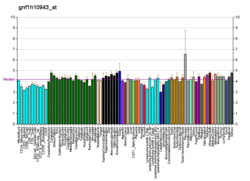| OR52J3 |
|---|
|
| Identifiers |
|---|
| Aliases | OR52J3, OR11-32, olfactory receptor family 52 subfamily J member 3 |
|---|
| External IDs | MGI: 3030426; HomoloGene: 66215; GeneCards: OR52J3; OMA:OR52J3 - orthologs |
|---|
| Gene location (Human) |
|---|
 | | Chr. | Chromosome 11 (human)[1] |
|---|
| | Band | 11p15.4 | Start | 5,046,526 bp[1] |
|---|
| End | 5,047,461 bp[1] |
|---|
|
| Gene location (Mouse) |
|---|
 | | Chr. | Chromosome 7 (mouse)[2] |
|---|
| | Band | 7|7 E3 | Start | 102,834,010 bp[2] |
|---|
| End | 102,842,172 bp[2] |
|---|
|
| RNA expression pattern |
|---|
| Bgee | | Human | Mouse (ortholog) |
|---|
| Top expressed in | - lung
- blood
- multicellular organism
|
| | | More reference expression data |
|
|---|
| BioGPS |  | | More reference expression data |
|
|---|
|
| Gene ontology |
|---|
| Molecular function | - G protein-coupled receptor activity
- olfactory receptor activity
- signal transducer activity
| | Cellular component | - integral component of membrane
- plasma membrane
- membrane
| | Biological process | - sensory perception of smell
- signal transduction
- response to stimulus
- detection of chemical stimulus involved in sensory perception of smell
- G protein-coupled receptor signaling pathway
| | Sources:Amigo / QuickGO |
|
| Orthologs |
|---|
| Species | Human | Mouse |
|---|
| Entrez | | |
|---|
| Ensembl | | |
|---|
| UniProt | | |
|---|
| RefSeq (mRNA) | | |
|---|
| RefSeq (protein) | | |
|---|
| Location (UCSC) | Chr 11: 5.05 – 5.05 Mb | Chr 7: 102.83 – 102.84 Mb |
|---|
| PubMed search | [3] | [4] |
|---|
|
| Wikidata |
| View/Edit Human | View/Edit Mouse |
|

















